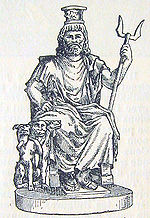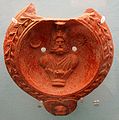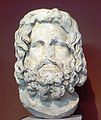- Serapis
-
For other usages, see Serapis (disambiguation).
Serapis or Sarapis was a Graeco-Egyptian god. He was invented during the 3rd century BC on the orders of Ptolemy I of Egypt as a means to unify the Greeks and Egyptians in his realm. The god was depicted as Greek in appearance, but with Egyptian trappings, and combined iconography from a great many cults, signifying both abundance and resurrection. His cultus was spread as a matter of deliberate policy by the Ptolemaic kings, who also built a splendid Serapeum in Alexandria. Serapis continued to increase in popularity during the Roman period, often replacing Osiris as the consort of Isis in non-Egyptian temples. The destruction of the Serapeum by a mob led by the Patriarch Theophilus of Alexandria in 389 is one of the key events in the downfall of ancient paganism, and the cult ceased to exist with the abolition of paganism in 391 AD.
Contents
About the god
Both spellings Serapis and Sarapis are recorded. "Serapis" is used in Latin, but both appear in Greek, e.g. (Ancient Greek: Σάραπις).
His most renowned temple was the Serapeum of Alexandria.[1] Under Ptolemy Soter, efforts were made to integrate Egyptian religion with that of their Hellenic rulers. Ptolemy's policy was to find a deity that should win the reverence alike of both groups, despite the curses of the Egyptian priests against the gods of the previous foreign rulers (i.e Set who was lauded by the Hyksos). Alexander the Great had attempted to use Amun for this purpose, but he was more prominent in Upper Egypt, and not as popular with those in Lower Egypt, where the Greeks had stronger influence. The Greeks had little respect for animal-headed figures, and so a Greek-style anthropomorphic statue was chosen as the idol, and proclaimed as the equivalent of the highly popular Apis.[2] It was named Aser-hapi (i.e. Osiris-Apis), which became Serapis, and was said to be Osiris in full, rather than just his Ka (life force).
History
The earliest mention of a Serapis is in the disputed death scene of Alexander (323 BC).[3] Here, Serapis has a temple at Babylon, and is of such importance that he alone is named as being consulted on behalf of the dying king. His presence in Babylon would radically alter perceptions of the mythologies of this era, though fortunately it has been discovered that the unconnected Babylonian god Ea (Enki) was titled Serapsi, meaning 'king of the deep', and it is possible this Serapsi is the one referred to in the diaries. The significance of this Serapsi in the Hellenic psyche, due to its involvement in Alexander's death, may have also contributed to the choice of Osiris-Apis as the chief Ptolemaic god.
According to Plutarch, Ptolemy stole the cult statue from Sinope, having been instructed in a dream by the "unknown god" to bring the statue to Alexandria, where the statue was pronounced to be Serapis by two religious experts. One of the experts was of the Eumolpidae, the ancient family from whose members the hierophant of the Eleusinian Mysteries had been chosen since before history, and the other was the scholarly Egyptian priest Manetho, which gave weight to the judgement both for the Egyptians and the Greeks.
Plutarch may not be correct, however, as some Egyptologists allege that the Sinope in the tale is really the hill of Sinopeion, a name given to the site of the already existing Serapeum at Memphis. Also, according to Tacitus, Serapis (i.e., Apis explicitly identified as Osiris in full) had been the god of the village of Rhakotis before it expanded into the great capital of Alexandria.
The statue suitably depicted a figure resembling Hades or Pluto, both being kings of the Greek underworld, and was shown enthroned with the modius, a basket/grain-measure, on his head, since it was a Greek symbol for the land of the dead. He also held a sceptre in his hand indicating his rulership, with Cerberus, gatekeeper of the underworld, resting at his feet, and it also had what appeared to be a serpent at its base, fitting the Egyptian symbol of rulership, the uraeus.
With his (i.e. Osiris's) wife Isis, and their son Horus (in the form of Harpocrates), Serapis won an important place in the Greek world,[4] reaching Ancient Rome, with Anubis being identified as Cerberus. In Rome, Serapis was worshiped in the Iseum Campense, the sanctuary of the goddess Isis located in the Campus Martius and built during the Second Triumvirate. The Roman cults of Isis and Serapis gained in popularity late in the 1st century thanks to the god's role in the miracles that the imperial usurper Vespasian experienced in the city of Alexandria, where he stayed prior to his return to Rome as emperor in 70 AD. From the Flavian Dynasty on, Serapis sometimes appeared on imperial coinage with the reigning emperor. The great cult survived until 385, when a Christian mob destroyed the Serapeum of Alexandria, and subsequently the cult was forbidden by the Theodosian decree.
The Alexandrians were syncretic, and a letter inserted in the Augustan History, ascribed to the Emperor Hadrian, refers to this indifference:
The land of Egypt, the praises of which you have been recounting to me, my dear Servianus, I have found to be wholly light-minded, unstable, and blown about by every breath of rumour. There those who worship Serapis are, in fact, Christians, and those who call themselves bishops of Christ are, in fact, devotees of Serapis. There is no chief of the Jewish synagogue, no Samaritan, no Christian presbyter, who is not an astrologer, a soothsayer, or an anointer. Even the Patriarch himself, when he comes to Egypt, is forced by some to worship Serapis, by others to worship Christ.[5]
Gallery
-
Mouldmade lamp with a bust of Serapis, flanked by a crescent moon and star. Roman, made in Ephesus 100-150. Said to be from Egypt. British Museum
-
Hellenistic-Roman terracotta head of Serapis, iconographically close to Zeus (Staatliches Museum Ägyptischer Kunst, Munich)
-
Statuette of Serapis from Begram, Afghanistan
See also
- Serapeum
- Serapis Bey, the Ascended Master in charge of the Ascension Temple
Notes
- ^ "Of the Egyptian sanctuaries of Serapis the most famous is at Alexandria", Pausanias noted (Description of Greece, 1.18.4, second century AD), in describing the Serapeion at Athens erected by Ptolemy on the steep slope of the Acropolis: "As you descend from here to the lower part of the city, is a sanctuary of Serapis, whose worship the Athenians introduced from Ptolemy."
- ^ According to Sir J.G. Frazer's note to the Biblioteca of Pseudo-Apollodorus, 2.1.1: "Apollodorus identifies the Argive Apis with the Egyptian bull Apis, who was in turn identified with Serapis (Sarapis)"; Pausanias also conflates Serapis and Egyptian Apis: "Of the Egyptian sanctuaries of Serapis the most famous is at Alexandria, the oldest at Memphis. Into this neither stranger nor priest may enter, until they bury Apis" (Pausanias,Description of Greece, 1.18.4).
- ^ Reported from Arrian, Anabasis, VII. 26.
- ^ In his Description of Greece, Pausanias notes two Serapeia on the slopes of Acrocorinth, above the rebuilt Roman city of Corinth (2.4.5) and one at Copae in Boeotia (9.24.1).
- ^ Firmus et al. 8 Historia Augusta 8.
References
Categories:- Serapis
- Egyptian gods
- Underworld gods
-
Wikimedia Foundation. 2010.





